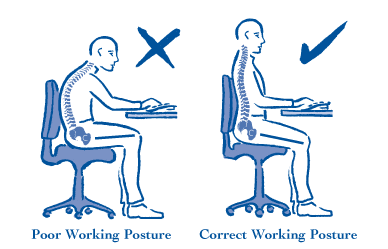Low back pain is a common symptom reported among the majority of the population. Generally caused by direct trauma from an injury or as a result of an aggravated condition, low back pain can greatly restrict an individual's daily activities, affecting their overall physical as well as mental performance. Although there's a variety of factors which can lead to back pain along the lumbar area of the spine, an incorrect sitting posture over an extended period of time has been known to be one of the leading causes for this well-known symptom.
Sitting is one of the most difficult positions for the body to maintain. Improper sitting postures for prolonged periods of time while hunched over in a chair can build excessive pressure on the spine and affect the blood circulation in the legs. For an individual that spends their workdays sitting down, the long term result of an improper posture can greatly alter the individual’s overall health.
Proper Posture While Sitting
Sitting for extended periods of time while hunching over a desk can cause discomfort, numbness and spine misalignment over time if the improper sitting posture is not corrected. Holding the body upright can also further increase pressure and tension in muscles, ligaments, joints, and other tissues surrounding the spine. A sedentary lifestyle where the individual doesn’t take frequent breaks throughout their workday to stand and stretch can gradually lead to cardiovascular disease due to the decreased blood flow, tightened hip flexors, shortened hamstrings, pinched nerves and many other physical injuries and/or conditions in the long run.

How Chiropractic Differs from Traditional Care
Aches and pains on the body, particularly around the spine, herniated discs, nerve complications and painful joints are direct results of working while in improper sitting postures for prolonged hours of the day. When you're in a seated position, a lot of pressure is being placed directly on the spine and its surrounding structures. Our bodies were designed to stand upright and maintaining a seated position can be physically stressful.
"The weight is distributed while in a standing position," explained Kelly McGonigal, Ph.D., a health psychologist at Stanford University and a leading expert in neck and back pain, “That's not the case with sitting. McGonigal added, "When you sit, you distort the natural curve of the spine, which means your back muscles have to do something to hold your back in shape because you're no longer using the natural curves of the spine to lift yourself up against gravity."
Approximately 80 percent of individuals in the United States alone may experience some form of chronic pain in their lifetime. Ultimately, working on a sitting position for extended periods of time per day is putting a tremendous mental and physical stress on our bodies.
Correcting Posture
Maintaining good posture when sitting helps preserve the three natural curves of a healthy spine; the cervical curvature, the thoracic curvature, and the lumbar curvature. The normal curvatures of the spine should form a slight S-shape. An excessive curve in the spine could suggest a possible underlying condition and may present symptoms of pain and discomfort, among other uncomfortable symptoms.
The key to maintaining a proper posture is to avoid slouching by sitting up straight as well as sitting all the way back in your chair. Additionally, the chair should be tucked in close to the desk. Placing a pillow or cushion directly behind your lower back area, or the lumbar spine, can help sustain good posture by providing enough support and allowing the spine to naturally curve inward. Furthermore, it’s also recommended to stand and stretch about every 20 minutes to give your body a break from long held positions, release pressure that is being built up on the spine and restore the body’s regular circulation by pushing the blood out of your legs. Doing this consistently throughout your day can prevent the muscles, ligaments and other tissues of the body from getting strained. Simple stretches at your desk, such as twisting, turning the head from side-to-side and chin tucks upward towards the ceiling can also help. These movements will ultimately help to relieve an individual’s chronic pain as well as restore an individual’s health progressively over time and improve their overall well-being.
Sitting is one of the most difficult positions for the body to maintain. Sitting for prolonged periods of time while hunched over in a chair can build excessive pressure on the spine and affect the blood circulation in the legs. For an individual that spends their workdays sitting down, the long term result of an improper posture can greatly alter the individual’s overall health.
While for many individuals sitting behind a desk for a prolonged period of time each day is an inevitable and often necessary part of their lifestyle, practicing a proper posture as well as seeking the proper care once the symptoms of low back pain manifest can change the effect of the issue. Chiropractic care as well as physical therapy and other forms of treatment, are available to the public to help reduce their painful symptoms and restore their original functionality. The spine is one of the body's most important structures and it's essential to maintain its health to achieve overall wellness.
For more information, please feel free to ask Dr. Jimenez or contact us at 915-850-0900 .
By Dr. Alex Jimenez





